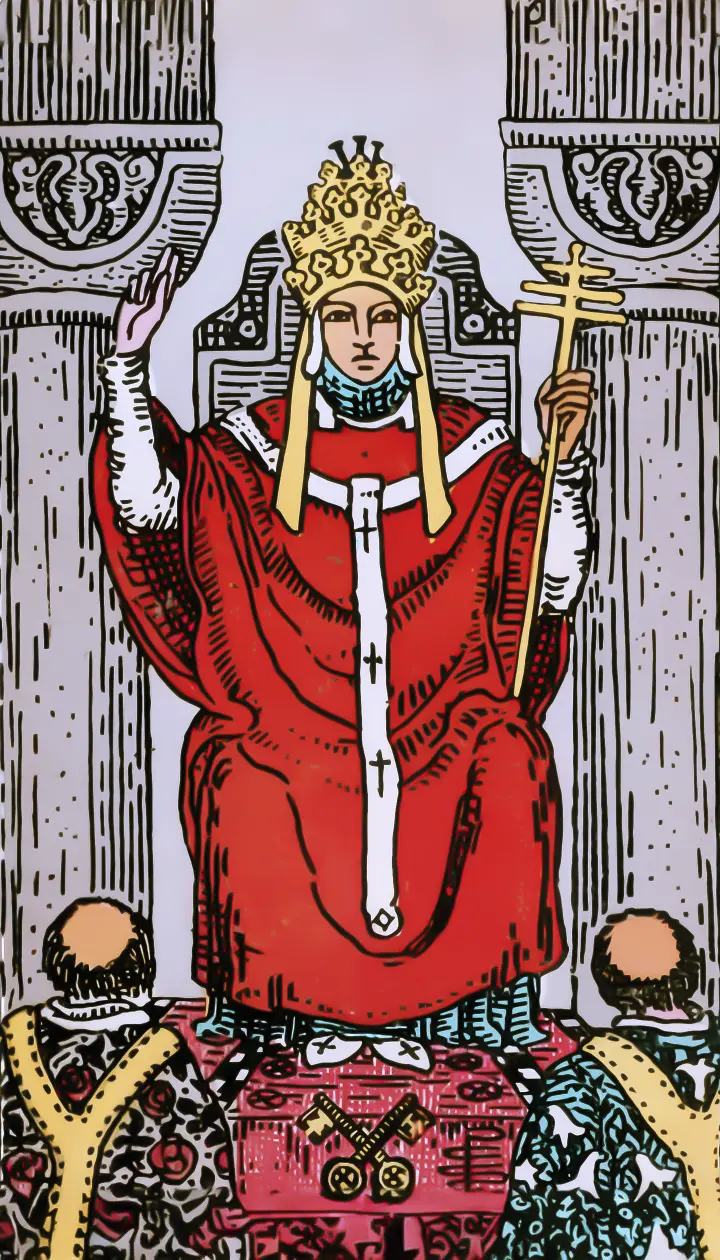
The Hierophant Card Fully Explained
By DivinationToolThe Hierophant represents spiritual authority, tradition, and mentorship. This article explores the upright and reversed meanings of The Hierophant card and its deeper significance in matters of wisdom, learning, and moral structure.
The Hierophant Card Fully Explained | Spiritual Guidance and Inner Order
Associated Information
Related Words: The tangible material world and conservative forces Corresponding Astrological Sign: Taurus Element: Earth
Key Words
Religious, guiding, truthful, teaching, professional, related to learning, spiritual beyond the material realm, spiritual authority.
Upright Interpretation
Wise, good at communication, timely assistance, discovering truth, spiritual support, help from a benefactor, an influential mentor, finding the right direction, academic support, elder interference in love matters, help from a matchmaker. From the Empress to the Emperor to the Hierophant, they respectively represent the mother, the father, and the spiritual paternal figure—the conceptual framework of a family. The mother's role is to provide care and affection, not only material support but also warmth and intimacy, telling the child that life is beautiful. The father's role is to foster independence and shape the child’s personal character, encouraging separation from the mother and the development of self-expectations. The spiritual father teaches the child the principles and order of society, guiding them into the world. These three form the parental archetypes within every person’s psyche, forming the foundation of love.
Reversed Interpretation
Overly dependent, misleading guidance, blind consolation, ineffective help, dictatorial, overwhelming, brainwashing, gaining approval through improper means, incompetent, love being sabotaged, third-party interference.
The reversed Hierophant indicates the transmission of false information and communication breakdowns. It’s important to beware of false hierophants with ulterior motives, such as those found in cult-like organizations who exalt themselves as saviors, saying things like “Follow me to reach heaven.”
The reversed Hierophant overly emphasizes the top-down dynamic, where the student has ulterior motives, seeking to obtain the “key” held above.
On another level, the reversed Hierophant may indicate that in a relationship, one party overly depends on an authority figure, neglecting their own abilities and losing the freedom to make personal choices. If the reversed Hierophant appears in a session, it’s a sign I may be too involved in the client’s matters, acting too much as a guide and overlooking that many things are the client’s lessons and decisions to make. It’s important to discuss with the client whether our relationship lacks flexibility and to restore mutual respect.
Detailed Meaning of the Card
The Hierophant is a card of wisdom and spiritual guidance.
The number “5” represents something beyond the four classical elements—a fifth, mystical element that transcends the material world. While the Emperor governs the realm of tangible reality, he lacks spiritual depth. Thus, the fifth card—the Hierophant—embodies spiritual authority.
The Hierophant is a man of mature wisdom. Compared to the High Priestess’s mystical knowledge, the Hierophant’s power differs—his spiritual strength and divine authority surpass that of the High Priestess.
The Hierophant represents support, but it is spiritual rather than material support—guidance and mentoring rather than direct assistance, pointing the way to truth.
As the third of the “three royal” Tarot cards, alongside the Empress and the Emperor (who rule over the material and political realms), the Hierophant is the sovereign of the spiritual plane.
In the card, he points one hand toward the sky, symbolizing his role as a transmitter of divine will. His mission is to offer guidance and teaching.
To the collective, the Hierophant reveals structure and rules, which may appear restrictive but also serve to protect. In society, people need authority figures to ensure cohesion and development. In some countries, religion and governance are deeply intertwined—this reflects the phenomena shown in the Hierophant card.
The two clerics before him are there to receive his teachings. In modern terms, they may represent student-teacher relationships or goal-oriented groups. The keys at the bottom symbolize access to crucial knowledge—keys to understanding. When the Hierophant appears, it often supports learning.
In relationships, the card tends to lack romantic passion and more often implies a power imbalance—such as teacher-student or helper-recipient dynamics. If romance is involved, the Hierophant likely represents a matchmaker or elder introducing the couple.
In well-established relationships, the presence of the Hierophant in a sacred space like a church suggests the possibility of marriage.
In work settings, the Hierophant may indicate the presence of a kind, guiding figure who leads, delegates tasks, and organizes plans.